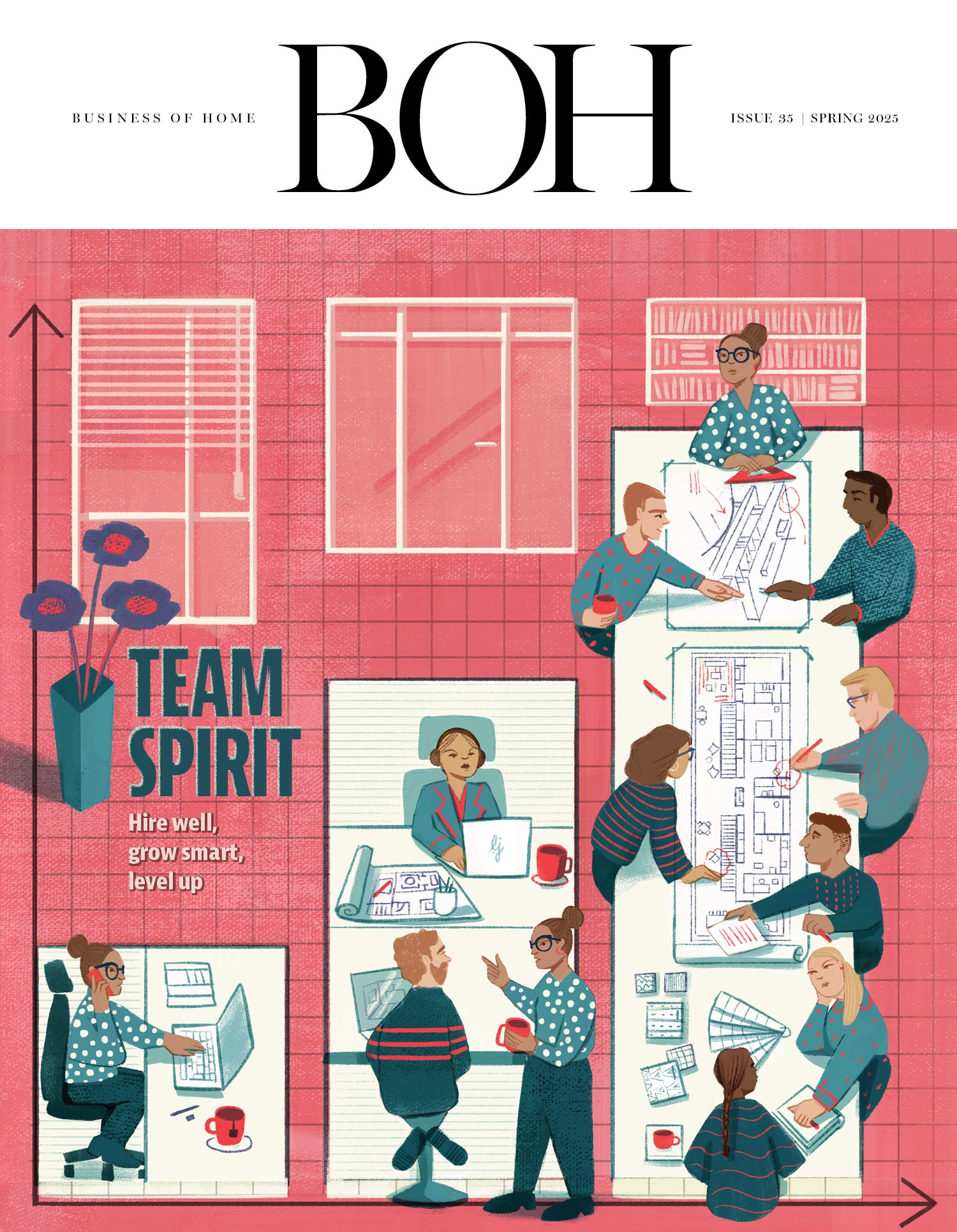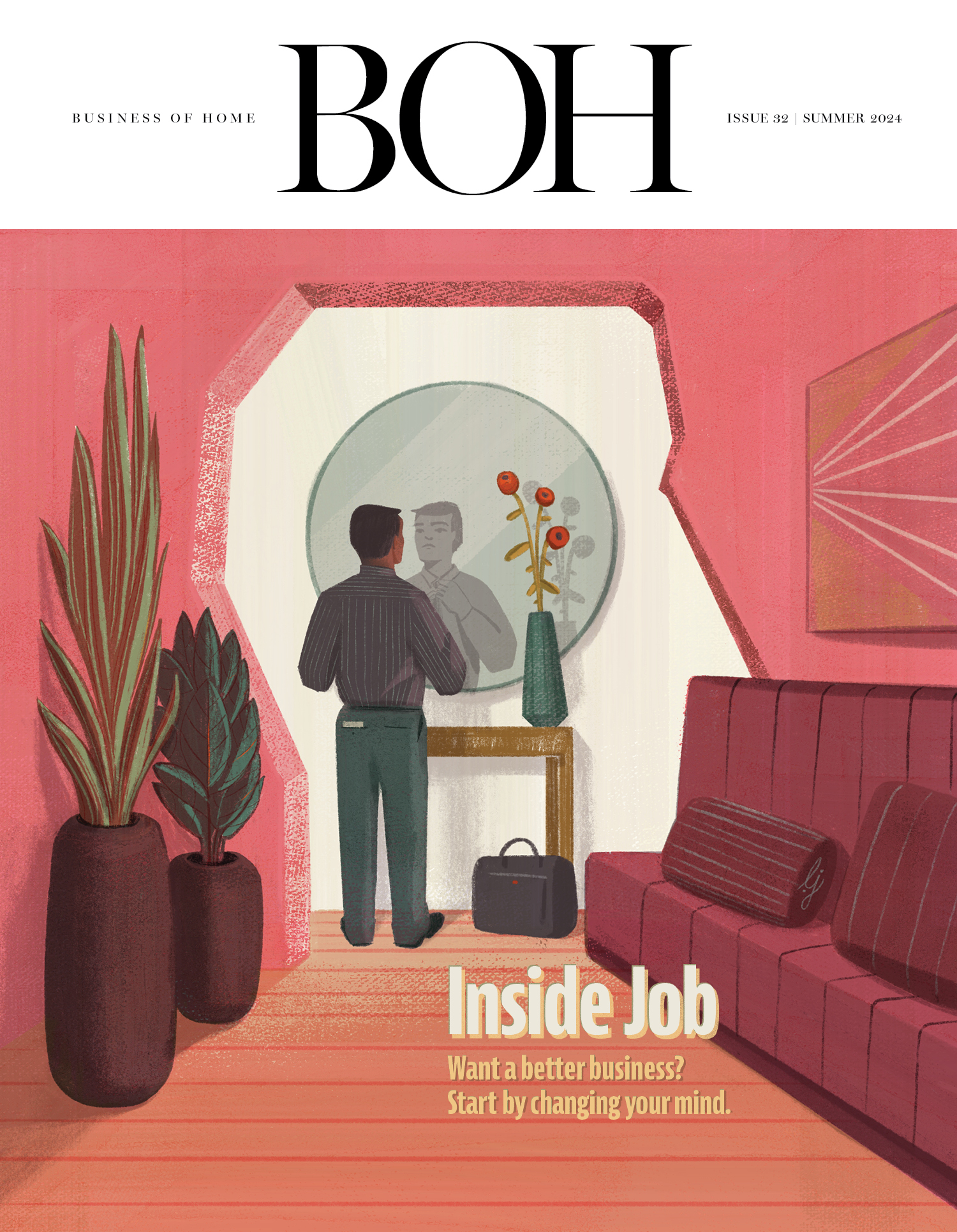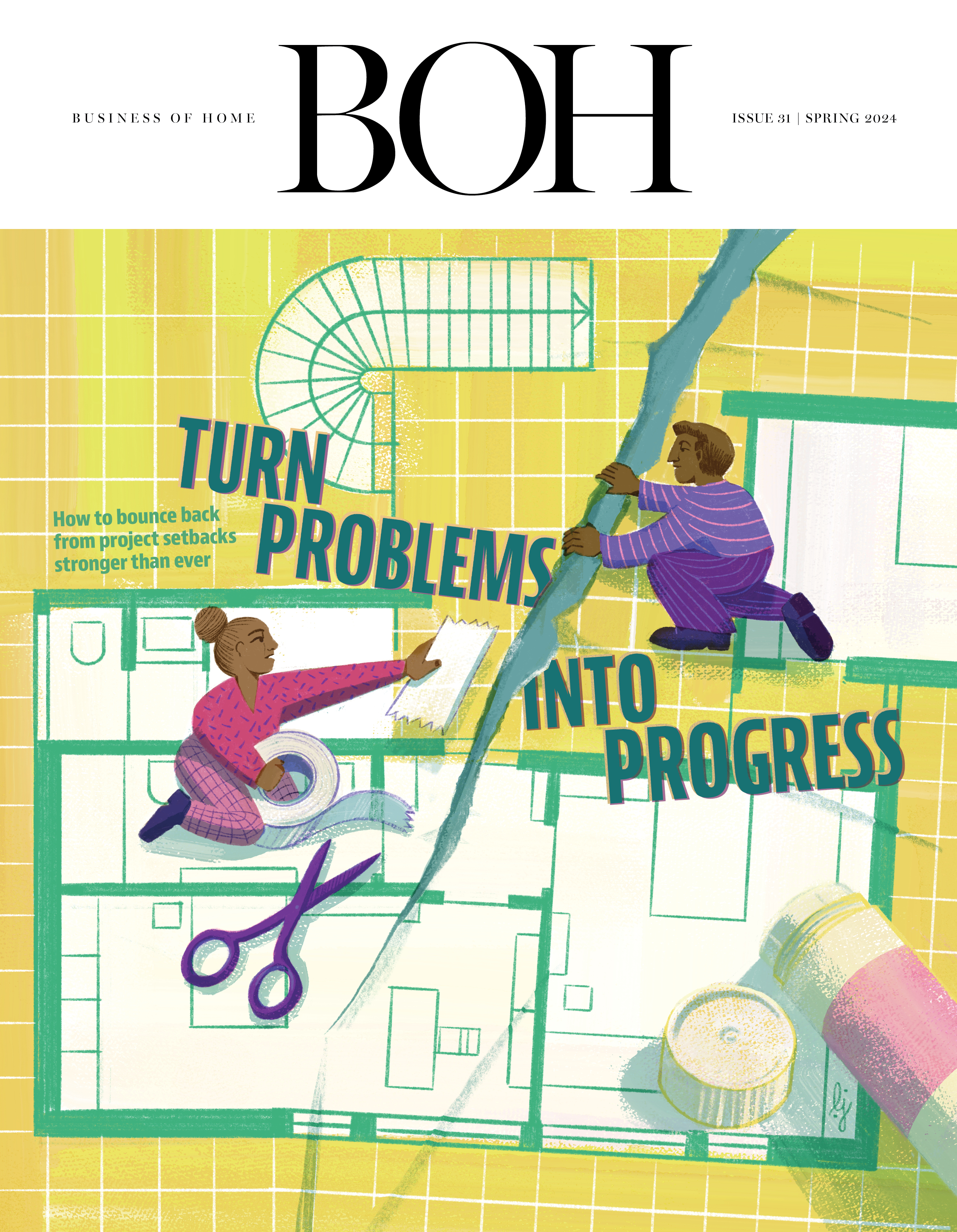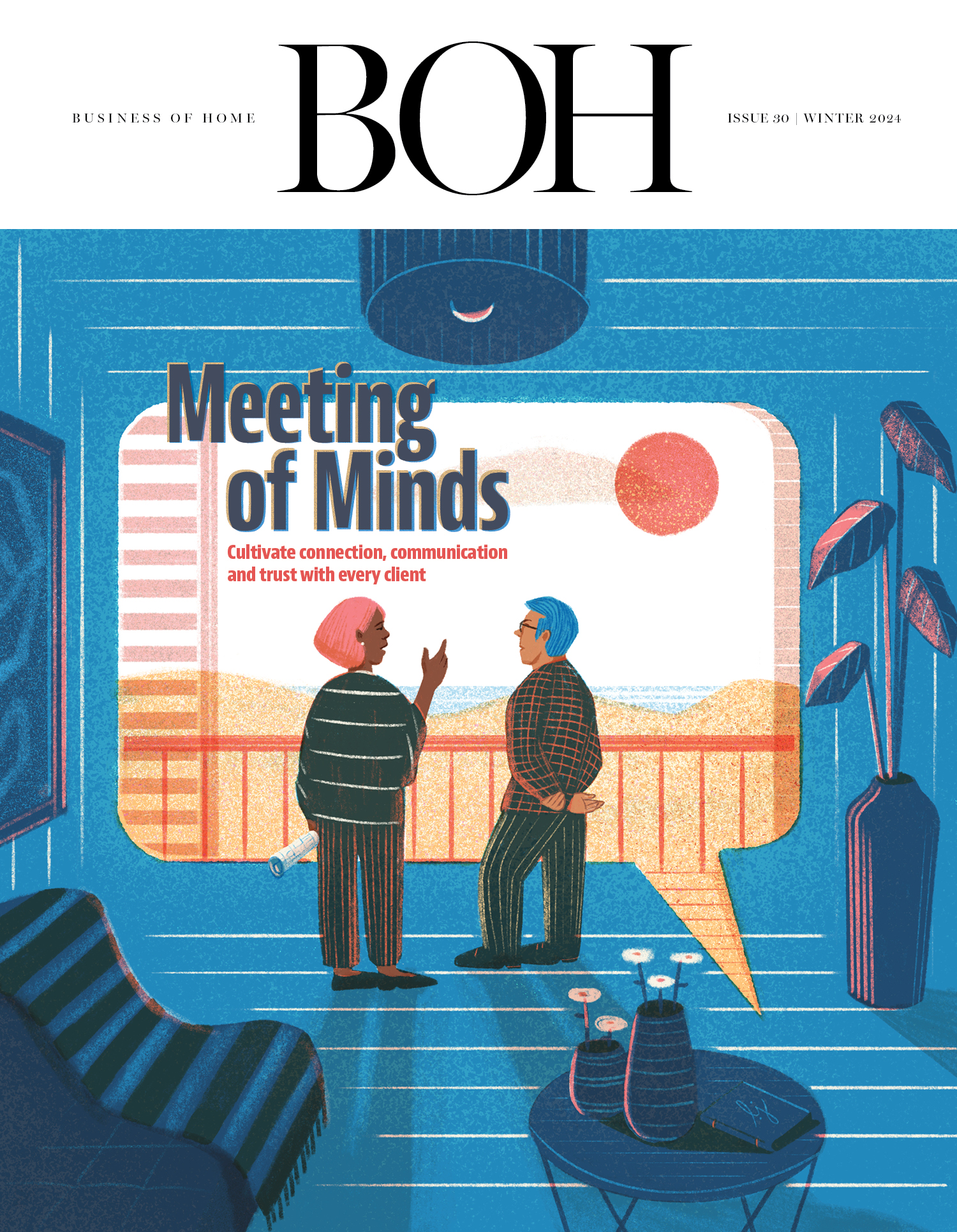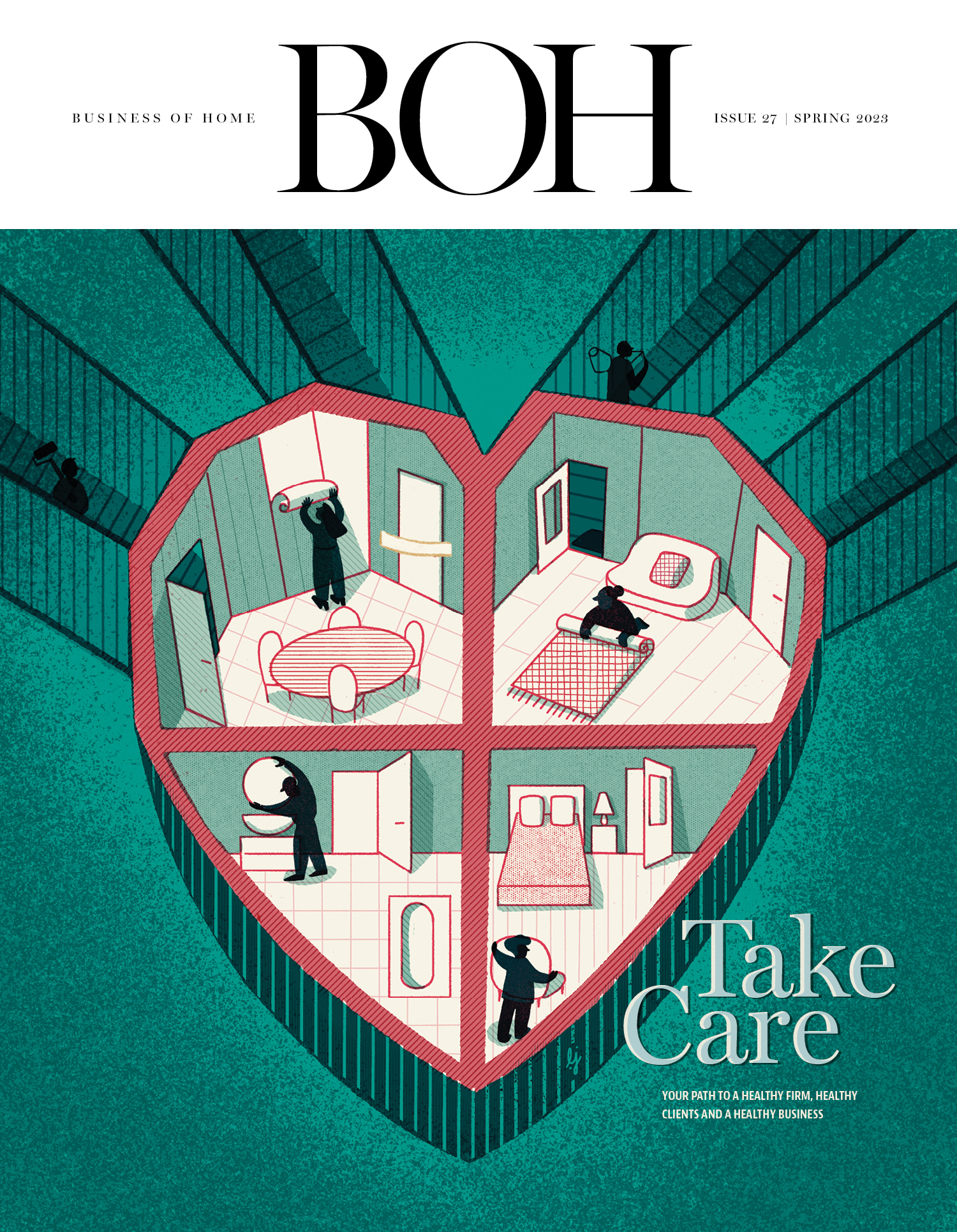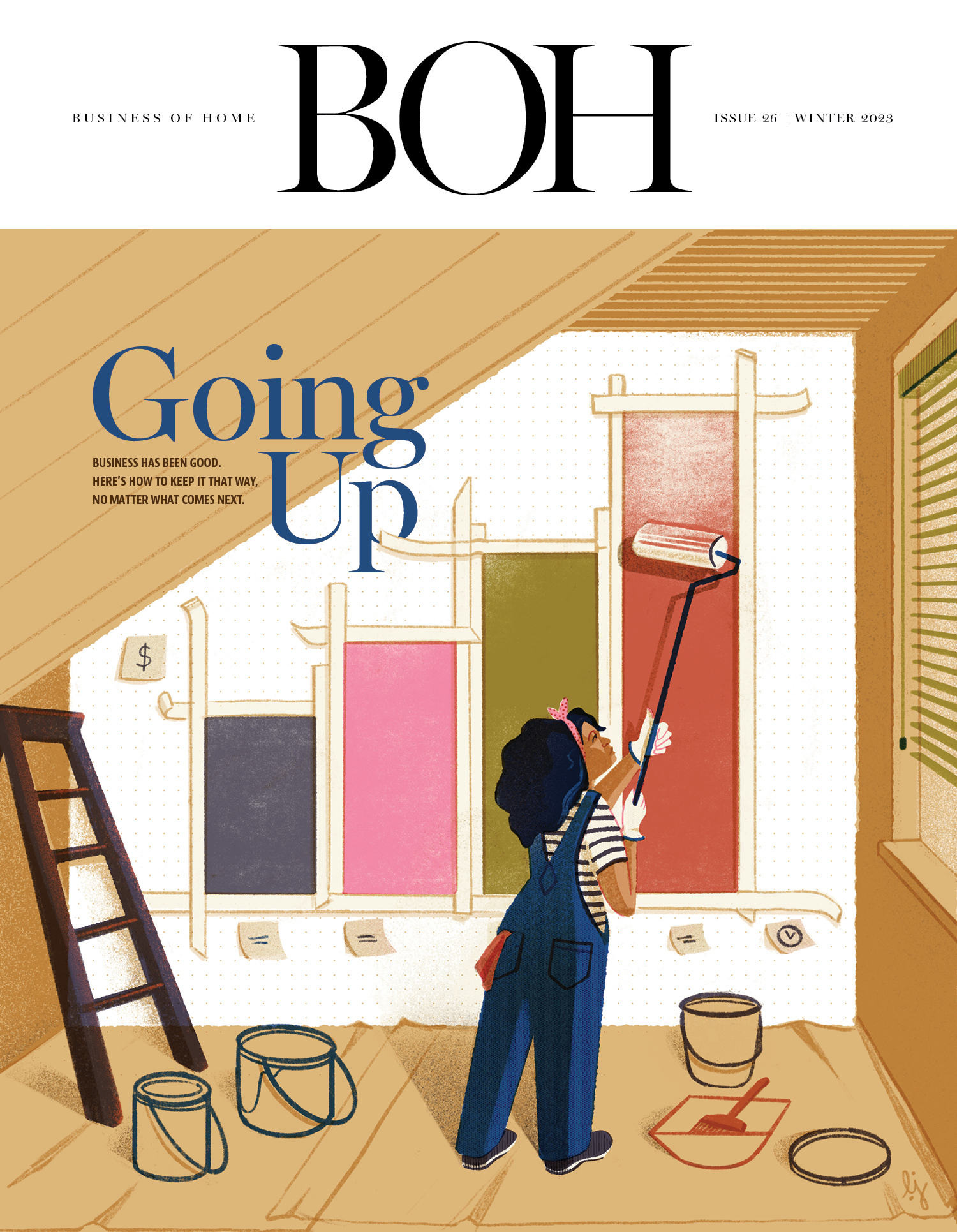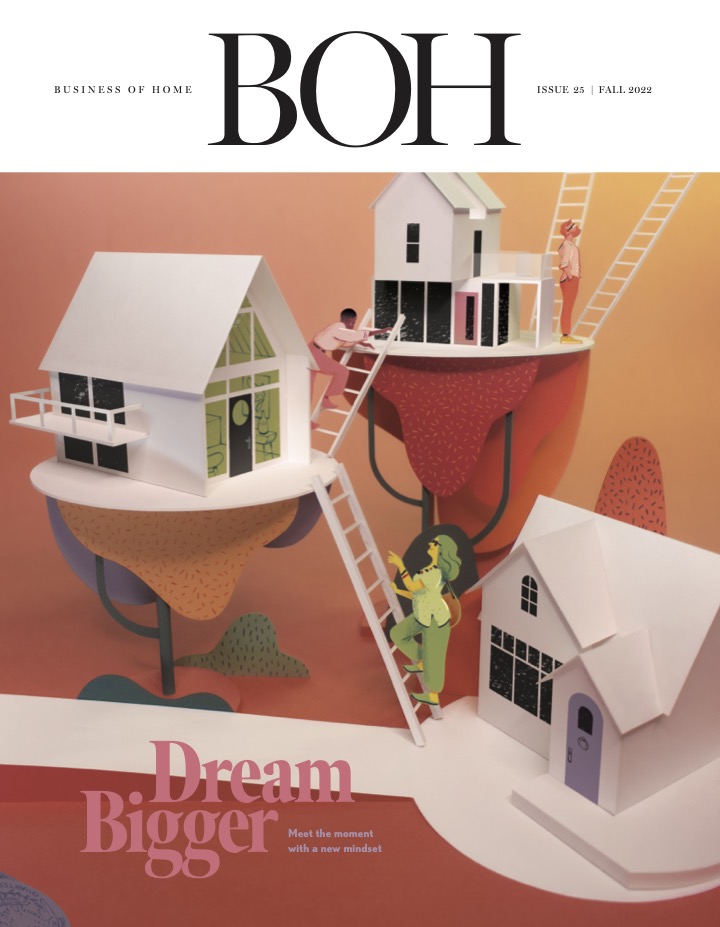In Business of Home’s series Shop Talk, we chat with owners of home furnishings stores across the country to hear about their hard-won lessons and challenges, big and small. This week, we spoke with interior designer Tracy Lorton Salisbury, owner of home goods store TA Lorton in Tulsa.
Lorton’s career trajectory unfolded slightly backward from the many shop owners who pass our desk. Instead of opening a showroom to serve as an extension (and advertisement) for her design services, she didn’t begin working more seriously as an interior designer until she’d been a retail owner for nearly three decades. She launched TA Lorton—which has gone through four moves and recently debuted a second location at Round Top—in 1988, when she was just 22.
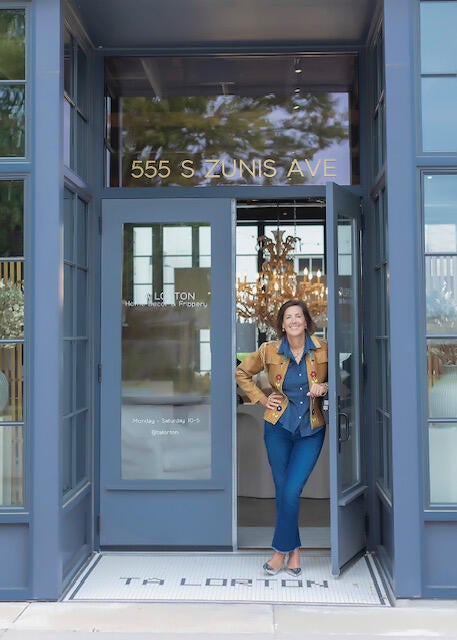
The tastemaker is thrilled, as she enters her 60s, to be finding new pathways for her career, which she describes as a celebration of frippery. “People ask, ‘What is frippery?’ And it’s just stuff. Don’t take your stuff so seriously,” she says. Ahead, Lorton explains why she was inspired to open her store at such a young age, how she worked around parenthood and recessions over the years, and why you should always stock a few big-ticket items.
How did the shop begin?
I graduated from college with a degree in elementary education, and I’d always worked in and liked stores. I went to lunch with a man who owned a store in Tulsa, Miss Jackson’s, one of those old-guard stores, with everything from clothing to interior [objects]. I said, “I think I want to open a store,” and he looked at me and said, “No.” That was a bummer, but it put a little gumption into me. I moved to New York, and people would ask all the time: “Who did your apartment?” I didn’t know what that even meant. I just bought stuff. In high school, I went to Laura Ashley and collected all the little pieces of sample fabric and sewed them together to make a duvet cover. And people kept asking, “Will you make me one?” So I had a weird knack. People would always ask me, “Where’d you get that?”
Then this spot opened up in Tulsa. It was a tiny little space, and I knew the rent, and thought “Maybe I can do it.” And a year later a space opened next door, which was triple the size, and I moved in. I’d go to market, and it was such a different world. We weren’t online. My friends were getting married and registering, and that’s [the frame of mind I would use when] buying: “Wow, look at these great dishes. I haven’t seen them anywhere else.” [The store’s selection has] always been guided by me and what I’m looking for in my house. When I had kids, we had a kids section, and then I was always obsessed with linens, so I’d have great bedding.
On July 9, strategist Ericka Saurit, in part two of her Social Storytelling series, dives deeper into the visual side of self-promotion, dissecting how your Instagram feed, stories and content work together to deliver a cohesive, scroll-stopping message about your unique design brand. Click here to learn more and remember, workshops are free for BOH Insiders
We want to hear your thoughts! Take BOH’s annual reader survey, an 8-minute questionnaire that helps us get to know you better and will allow us to tailor our storytelling to your business needs.
When I had kids, I didn’t know if I was going to be able to keep the store open and be home. I had twins first, but somehow I managed it. The New York Gift Show was efficient. There were all these great vendors from Europe. You could go twice a year and really knock it out of the park.
So I was 10 years into [running] that first location, and then a friend of mine, Charles Faudree—a beautiful decorator who has [published] six books—bought a building nearby. I moved there for 19 years, and that area blew up, and I was in another spot for six years. Right before Covid, I was finally looking for a building, which I should have done years before. [I found] where I’ve landed—it’s 10,000 square feet, [built in] 1929. The setting is so dreamy now. I’d only ever been in 3,000 square feet.
How did you pivot to designing interiors?
Over the years, I’d have people say, “Will you help me with my house?” I never really thought I was nice enough to be a decorator; I’m super decisive. I’ve got about three things to say. I’m not a great salesperson. When I fall in love with something and I know it’s perfect, I’d rather show you. I’d rather walk you into a room and then you go, “Oh wow, I get it. This is unbelievable.” I would rather put my head down and pull a room together—and that’s what I do over and over again in the shop. I mean, it is about selling it, but it’s not really about that. It’s more: “Look at this. I’m in love! Look at what I found.” If they happen to love it, that’s wonderful. If they don’t, I’ll move on to something else. But for the most part, I was just busy with my kids and enjoying the shop and making it as beautiful as I can.
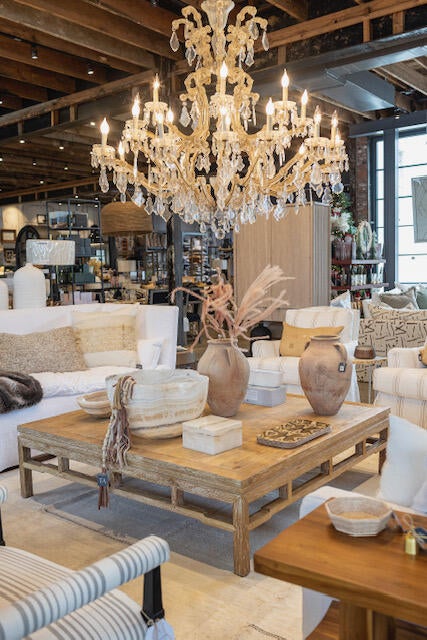
Then, I had enough people say, “Will you just come and tell me if this is the right coffee table for me?” My youngest turned 16 and I [finally] wasn’t racing out to school and sports and I had a little bit more time. I just started opening that door and helping people. And even though I’d been at it for years, it was an interesting transition. I say to myself, “Do I know what I would do if that was my house?” Well, yeah, and in a heartbeat, I can think of 20 things. So I just stay on that course.
And when was that shift?
About 10 years ago. We live slightly outside of town, and had this Morton barn. I’d bought some case goods, but we had a smaller shop and I needed a bigger space for them. So I created a bit of a showroom at home. I was, like, the girl with the truck: “Here’s some great pieces. Let me bring this.” If I could get into somebody’s house, I’d be able to instantaneously transform their room. They’d sit on the sofa and I would sell the coffee table, because it made the rest of the room complete. It took off from there. Last summer I turned 60, and I’ve always gone down to Round Top and packed a truck, and somebody said: “You should open a shop here.” So now I’ve opened a permanent 3,000-square-foot showroom at Round Top. People have always said to me, “I can’t believe this shop is in Tulsa. I live in San Francisco, or Austin, and I wish you could open there.” I think, “Do I have the bandwidth for that? Is it about my ego? Does it bring more joy to my life?” But at Round Top, I’ll look up and there’s 19 people in the shop. We’re having a blast. It’s fun to be 60 and still learning.
OK, because you said it first—I can’t believe this place is in Tulsa! It’s a bit edgy. How would you describe your style, and what customers does it draw?
Well, I appreciate you saying that. It always makes me feel good, weirdly. I did live in New York, and I’ve been all over the place. The people who live on the coasts, they would never dream of coming to Oklahoma. They have an image of it. [But Tulsa is] a very cosmopolitan town! There are very sophisticated people who live here. Then you have the people who drive in their big dually and have a ranch, but they have fantastic taste too. I try to bring something people haven’t seen, because I just buy what I love. I bought Hôtel Silver [tableware] a hundred years ago, when people were like, “What is this?” And then Pottery Barn knocked it off, and then you’ve got to move on. Sometimes I’m about three years too early. But I’ve been around a long time. I’ve seen a lot of stuff. What is my style? It’s changing. I love contrast, I love a mix. It’s eclectic, it’s crusty, and then it’s smooth. I love texture. I think if I were a little more conservative, I would probably do better in Tulsa. But I’ve got to be me. I’ve got to love it.
If I’ve seen it too much, I’m probably going to move on. We get shopped a lot by other stores. I feel it now, even online. You’ve got to be protective of your lines. I don’t really take offense at that, but it’s tiring. There’s this great dealer out of Nashville that had the most beautifully staged place at Round Top, and they get a lot of their things from Belgium. He was fussy about people finding his sources, and at one point I said, “Does it really matter? You are always moving forward. Nobody has your eye, so it doesn’t matter.” Nobody will do it better than you. It just means you’ve got to keep working hard.
What is your sourcing process like?
It’s my hardest thing. I’m constantly trying to figure out how to do it. Instagram has definitely helped. I don’t want to insult anybody, [but] with markets—Dallas, they just let everybody in. I cannot tolerate those big showrooms. They sell to everybody. I’ll find beautiful things, but it’s not exclusive enough anymore. Customers photograph everything in your shop, and then they’re going to source it—whatever that’s called when you Google [reverse-image-search] it. Now you’re competing against the internet. I only ever price things at the manufacturer’s suggested retail price, but there’s always somebody out there who’s got the same price but also maybe offers free shipping. You would put these [brands] on the map, and we all worked so hard to make it look beautiful in our stores. I don’t want this to be a “woe is me” thing. But it’s fascinating—a line is begging you to buy more and show it in your store, and you carry it year after year, and then [it] goes online at a lower price. You want me to buy from you and you’re undercutting me. How do they expect you to stay in business and come back the next year and buy again?
You’ve just got to keep moving, I guess. A hundred years ago, my friend Charles Faudree, who was just the best person, the most hysterical person in the world, said to me: “If you’re going to have a shop, you have to have a service.” That’s the only way I’m still at it; obviously, my service is interiors. The second you put the coffee table down, they’re like, “Now, what goes on the table?”
I spend hours on Instagram every night, just sitting there while I’m watching TV. I see something handcrafted and write them, “Do you do wholesale, by chance? If I buy this much, will you help me with price?” I love designers and I’m so grateful for them, and I have a few who come by when they’re completing a job or have a photo shoot. They’re selling my merchandise for me, but I always have to be like, “Wait a minute. Do I barely have a markup on that? Did I pay?” You’ve still got to have enough of a margin. I have designers who come in that are working with a client who’s using them to get their discount. I’m like, “Why are you passing on that discount?! It’s for you. You have the eye. You’re the one taking this into their house. You’re the one who has to return it. You’re doing the work!” I’m protective of them. I want you to make money!
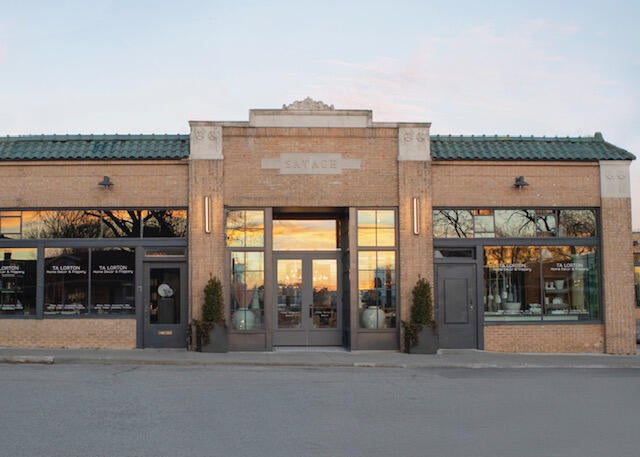
What is your own favorite category in the store?
I love upholstery. I love fabrics. I love textiles. I definitely love a vintage accessory. I love pottery. I wouldn't say that all of those categories are what sell the most, but it’s what I’m passionate about. My category would be “something handmade.”
I just love something that feels one of a kind. Do I get around enough to find those things? Probably not. But I’m busy. When I had kids, I couldn’t get to Europe anymore to find all the one-of-a-kinds. I couldn’t go to all those markets, which is why the New York show is so fantastic. I could do it twice a year and find stuff from all over the place. Shoppe Object is a good show, but I just want to tell them: “Keep finding the quirky.”
Your business has weathered so many different eras. How did you survive them? How do you prepare when you think another one is coming?
I think I put my head down and work my ass off. I turn my TV off. You have to give yourself a little cushion of cash. It’s coming. It’s here right now. I mean, I opened a shop at Round Top in October, right before an election, and that’s a tough time. Everybody’s frozen a little bit, with interiors and purchasing and buying.
I remember back in 2008 when everybody froze. But people still want to feel joy. That’s what people said when they came into the store. I would always make sure to have the $25 item—but then don’t shoot yourself in the foot by not having a $6,000 something, because there’s a person who can buy the $6,000 thing. I used to get paranoid and really listen to people who were like, “That’s so expensive. That’s crazy!” [But] you can’t sell an ottoman for $12,000 if you don’t have it. A piece that’s expensive to one person is not expensive to someone else. You’ve got to have those pieces in, because, by God, when they finally sell, you’ve finally made a little money.
You’ve got to remember the person who just wants to get out of their house. They’re in a rut and want to feel happy. If they can buy a little something ... You’ve got to keep pushing forward and just hang on, hang on, hang on. During the Covid shutdown, I had just bought a building. We got our permit to do work on the new place, and my husband said: “I think you need to wait. Let’s just get through Christmas.” I was like, “Honey, I had to buy furniture last October to furnish the 10,000-square-foot building. I’ve got furniture screaming down the highway! There’s no stopping it! I might as well open so I can get the stuff into the shop, photograph it, and then at least sell it on Instagram.” You have to keep stepping forward. When people could [finally] move, they were happy to have a space to come and see. You can’t focus on the negative. I never said we were closed. I said we could do curbside pickup. I’ve got puzzles! Puzzles aren’t going to pay my rent, but the cute restaurant next door is desperately trying to stay open, so I bought all her cookies. When you come in to pick up your puzzle, have a cookie. Here’s her menu—pick up dinner at the same time.
I definitely have a way of compartmentalizing and closing my ears off. Keep presenting and praising interesting things: “Oh my God, I’m obsessed with this. Look at this! It just came in.” I’ve had so many great friends with stores who have gotten tired and closed, and I get it. Then here I am, a wackadoodle, opening at Round Top. When am I retiring? Apparently I have a sickness. I can’t help myself.
Well, I’m glad we’re ending on how much you love it! What’s your favorite day at the shop?
I’m sort of a behind-the-scenes person. I’m not great on the floor. I hear the girls in the shop speaking to everybody, and they have a gift. I can talk to people, but I will distract them. The girls are always giving me the signal: Get to the back. They’re trying to sell something, and here I am talking about my children. And so, Sundays are my very favorite day. We’re not open on Sundays. I can go in and have quiet and be in my own head. Ooh, this is so fabulous with that. I love that pop. I photograph a vignette and put it on Instagram, and people say, “This is beautiful, Tracy!” They’re happy to see something pretty. I think it makes people feel that it’s a human person. That is a big part of the difference in a smaller brick-and-mortar shop—it’s a human person. It’s full of flaws. Not every area is just perfectly done. I’m not West Elm. It’s a 60-year-old woman who’s snapping a picture and posting it. I don’t know what I’m doing half the time, other than working hard and [finding] what feels good.



